Medicare
Medicare now covers over 65 million Americans and remains a cornerstone of the U.S. health care system. Yet the program faces mounting challenges—rising costs, plan complexity, and variation in access and quality.
Medicare
Medicare now covers over 65 million Americans and remains a cornerstone of the U.S. health care system. Yet the program faces mounting challenges—rising costs, plan complexity, and variation in access and quality.
About the Medicare Lab
CAHPR’s Medicare Lab brings together researchers evaluating reforms to address Medicare’s sustainability, transparency, and value for beneficiaries and taxpayers alike. Our work spans Medicare Advantage, Traditional Medicare, and supplemental coverage programs. Using administrative and claims data, the lab investigates issues such as coding intensity, price growth, plan performance, and benefit design. By combining rigorous evidence with policy simulation tools, we help inform legislative and regulatory reforms aimed at improving accountability, competition, and equity within Medicare.
The Big Questions
- Where can we design smarter incentives to reduce waste and unnecessary spending in Medicare?
- How do current payment rules and risk adjustment methods create incentives for upcoding or overbilling?
- How can oversight and accountability be strengthened to prevent inaccurate coding, inflated payments, or improper plan behavior?
![]()
Featured Work
Recent Publications
- U.S. Physician Medicare Program Participation and Exit, 2013-2023
- Medicare Advantage Plan Spending and Payments Under the Hospice Carve-Out
- Algorithmic decision-making in health care: Evidence from post-acute care in Medicare Advantage
- Accountable Care Organization Assignment and Outcomes and Spending for TEAM Surgical Conditions
- Sharp Rise In Urban Hospitals With Rural Status In Medicare, 2017–23
- Surgical Outcomes and Medicare Advantage Payer-Hospital Integration
Events & Policy Discussions
- Improving Medicare Advantage: Evidence-Based Reforms for a More Transparent and Sustainable Program
- Surgical Outcomes and Medicare Advantage Payer-Hospital Integration?
- Medicare Advantage Payment and Opportunities for Cost Containment
- The Future of Medicare: The Rise of Medicare Advantage and What Comes Next
MediCode Tool
The MediCode tool provides insights into how Medicare Advantage plans may be inflating risk scores and receiving billions in additional federal payments.
From Statehouses to Capitol Hill
Turning Evidence into Policy
Experts
-

David J. Meyers Ph.D., MPH
Medicare Lab Lead, Associate Director for the Center for Advancing Health Policy Through Research, Associate Professor of Health Services, Policy & Practice -

Cyrus M. Kosar Ph.D.
Assistant Professor of Health Services, Policy & Practice -

Jeffrey Marr Ph.D.
Assistant Professor of Health Services, Policy & Practice -

Andrew M. Ryan Ph.D.
Director for the Center for Advancing Health Policy Through Research, Professor of Health Services, Policy & Practice
Our funders:

.png)



